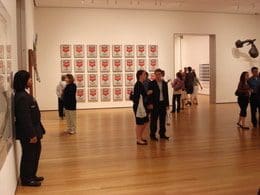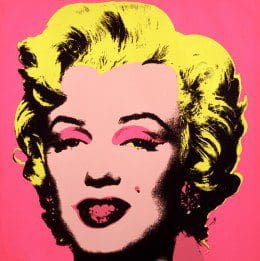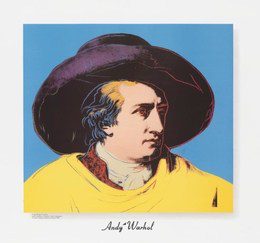One of my favorite art movements is Pop Art. One of my favorite American artists is the iconic artist Andy Warhol.
Andy Warhol is a Pop Artist and one of the Pop Art Movement’s significant figures. Andy Warhol’s artwork explored the relationship between what is known as the mass popular cultures of his day and art. He used many iconic American objects in his art and painted many celebrities. Andy Warhol had a talent for turning the ordinary into works of art.
Table of Contents
- Andy Warhol: A Pillar of Pop Art and the Master of Cultural Commentary
- Why Pop Art Become An Art Movement
- Andy Warhol and Street Graffiti.
- The Andy Warhol Museum
- Frequently Asked Questions
- Related Questions

Andy Warhol: A Pillar of Pop Art and the Master of Cultural Commentary
Andy Warhol, an iconic figure in the Pop Art movement, transformed the art world with his unique perspective on contemporary culture and art. Renowned for exploring the intertwining dynamics between mass popular culture and artistic expression, Warhol’s work reflects his time’s vibrant and rapidly evolving society.
His art, characterized by the use of quintessentially American objects and famous personalities, redefined the concept of artistry. Warhol had an extraordinary knack for elevating the mundane to the great, turning everyday items and familiar faces into profound artistic statements.
Andy Warhol -A Pop Artist
Andy Warhol (1928 – 1987), born Andrew Warhola, was an American artist, filmmaker, and producer who became a leading figure in the visual arts movement known as pop art. His artwork explores the relationship between artistic expression, advertising, and celebrity culture.
In speaking about Pop Art, Andy Warhol said:
“Once you ‘got’ Pop, you could never see a sign again the same way again. And once you thought Pop, you could never see America the same way again.”
Andy Warhol
To discover more about Pop Art, you can read our blog on What Is Pop Art In Simple Terms? by clicking here.

Andy Warhol’s Pop Artwork
In the 1960s, Warhol began painting iconic American objects such as dollar bills, mushroom clouds, electric chairs, Campbell Soup cans, and Coca-Cola bottles. With a fascination with Hollywood, he also painted many celebrities such as Marilyn Monroe, Elvis Presley, Marlon Brando, Tony Donahue, Muhammad Ali, and Elizabeth Taylor.
Andy Warhol made political statements as he used newspaper headlines or showed photographs of police dogs attacking African-American protesters during the Birmingham campaign in the civil rights movement. This artwork was part of the 1960s and 1970s Pop Art Movement.
Andy Warhol became a popular but controversial artist. In speaking about using ordinary objects in his work, Andy Warhol said this:
“I just happen to like ordinary things. When I paint them, I don’t try to make them extraordinary. I just try to paint them ordinary-ordinary.”
Andy Warhol
Why Pop Art Become An Art Movement
Pop art began in the late 1950s but really reached its peak in the 1960s. It revolted against the dominant and traditional approaches to art and culture at the time.
This revolt in the arts was very much in line with many things that were happening in the culture in both Britain and the United States at the time. In fact, the 1960s was known as one of the most tumultuous and despised divisive decades in world history.
The 1960s marked the civil rights movement, the Vietnam War, antiwar protests, political assassinations, and the emerging generation gap.
The 1960s was also the Woodstock era, rock ‘n’ roll, Charles Manson, drugs, sex, and hippies. As the world was changing, artists as Andy Warhol were also changing how art was viewed.
In speaking of the 1960s, Andy Warhol said this:
“During the 1960s, I think, people forgot what emotions were supposed to be. And I don’t think they’ve ever remembered.”
Andy Warhol

Andy Warhol and The Pop Art Movement Changes Art
Andy Warhol and the other Pop Art artists changed how art was viewed with the Pop Art Movement. Art would never be the same as it was before this powerful Pop Art Movement emerged.
With the emergence of the Pop Art movement, most art critics were horrified at the prospect of Pop Art becoming an art movement. Pop Art was an edgy art that pushed society’s art limits.
Pop Art wanted to change how art was viewed and did not care what the art critics thought about it. In speaking change, Andy Warhol said:
“They always say time changes things, but you actually have to change them yourself.”
Andy Warhol
Andy Warhol and the other Pop Artists set out to change how art was viewed. And Warhol’s willingness to change art made him an iconic art figure – even today.
The New York City’s Museum Of Modern Art symposium on Pop Art in December 1962 showed Andy Warhol and other pop artists’ ability to embrace change.
Pop artists like Andy Warhol were attacked for capitalizing on consumerism and the market culture with their art. This did not stop Andy Warhol or any of the other Pop Artists from producing their Pop Artwork.
In fact, Andy Warhol said how he viewed art and pushing change with art:
“Art is what you can get away with.”
Andy Warhol
Andy Warhol and Street Graffiti.
Many believe that pop art was what started the street art or graffiti movement. In fact, in the 1980s, the New York underground graffiti artist Fab Five Freddy paid homage to Andy Warhol when he painted an entire train with Campbell Soup cans.
Many believe that Warhol and other pop artists helped influence the emergence of street art or graffiti.
Many street artists or graffiti artists took their inspiration directly from pop artists like Andy Warhol. Street Art or Graffiti also had some similarities to Pop Art in that both are, in a sense, anti-establishment.

The Andy Warhol Museum
One of the best places to see the work of Andy Warhol and discover more about him is the Andy Warhol Museum in Pittsburgh, Pennsylvania. This art museum is in Pittsburgh, the town where Andy Warhols was born. It is considered one of the most comprehensive single-artist museums globally.
The Andy Warhol Museum is one of four Carnegie museums in Pittsburgh. The museum is a collaborative project between the Carnegie Institute, the Dia Art Foundation, and The Andy Warhol Foundation for the Visual Arts. The museum officially opened its doors in 1994.
The Andy Warhol Museum is open to the public on Monday, Wednesday, Friday, Saturday, and Sunday. They are closed on most public holidays.
To find out more about The Andy Warhol Museum you can visit The Andy Warhol Museum Webpage by clicking here.
The iconic Pop Artist Andy Warhol led a complex and inspirational life. Warhol has left us with a great legacy of Pop Art. But he has also shown us that we can be the kind of people who push the limits and work to change how art is viewed – even today.
Anita Louise Art is dedicated to art education, great artists, and inspiring others to find and create their art. We love art that uplifts and inspires. #ArtToMakeYouSmile! #ArtToMakeYouHappy!
If you want to see any of my art, you can find out more by clicking here. If you are interested in what inspires me and my paintings, you can discover more by clicking here.
We have a free newsletter and would love you to be part of our community; you can subscribe to the newsletter by clicking here. If you have any questions, I would be happy to talk to you anytime. You can reach me, Anita, by clicking here.
Subscribe to our Anita Louise Art YouTube Channel with great videos and information by clicking here.
Join us for our podcast “5 Minutes With Art.” just 5 minutes a week with us to discover and learn about great art and artists. You can find out more about our podcast by clicking here.
Frequently Asked Questions
Who is Andy Warhol, and what is he known for in the art world?
Andy Warhol is a renowned American artist known for being a leading figure in the Pop Art Movement. His art often depicted popular culture and everyday objects, challenging traditional notions of fine art.
What is Pop Art, and how does Andy Warhol fit into this art movement?
Pop Art is an art movement that emerged in the 1950s and 1960s, celebrating popular culture and mass media imagery. Andy Warhol is considered a central figure in Pop Art, using everyday objects and celebrities as subjects for his artwork.
What are some iconic themes in Andy Warhol’s artwork?
Warhol’s work often featured iconic American symbols and consumer products, such as Campbell’s Soup cans, Coca-Cola bottles, and celebrities like Marilyn Monroe. He transformed these ordinary items into subjects of high art.
How did Andy Warhol contribute to the relationship between art and popular culture?
Warhol blurred the lines between high art and popular culture by incorporating everyday objects and celebrity imagery into his art. His work questioned traditional artistic hierarchies and made art more accessible to a broader audience.
Why did Andy Warhol choose to focus on celebrities in his art?
Warhol was fascinated by celebrity culture and believed that fame was the ultimate form of modern currency. He often portrayed celebrities, such as Marilyn Monroe and Elvis Presley, to explore the impact of fame on society.
How did Andy Warhol use mass production techniques in his artwork?
Warhol embraced mass production techniques, such as silkscreen printing, to create multiple copies of his artwork. This approach reflected the mass-produced nature of consumer culture and challenged traditional notions of the uniqueness of art.
What is the significance of Warhol’s “15 Minutes of Fame” concept?
Warhol famously said, “In the future, everyone will be world-famous for 15 minutes.” This concept reflects his fascination with the fleeting nature of fame in a media-saturated society.
Did Andy Warhol only work in visual arts, or did he explore other forms of artistic expression?
While primarily known for visual arts, Warhol also ventured into filmmaking, producing avant-garde films such as “Chelsea Girls” and “Empire.” His exploration of various artistic mediums contributed to his avant-garde reputation.
How did Andy Warhol’s Factory influence his artistic process?
Warhol’s studio, known as The Factory, served as a creative hub where artists, musicians, and celebrities collaborated. It became a symbol of the intersection between art and popular culture, influencing Warhol’s artistic process and output.
What is the legacy of Andy Warhol in the contemporary art world?
Andy Warhol’s legacy is profound, as he revolutionized the art world by challenging conventions and bringing everyday life into artistic expression. His influence is still evident in contemporary art, especially in the fusion of popular culture and artistic creation.
Related Questions
What Was the Cubism Art Movement?
Cubism is an early 20th-century avant-garde art movement that helped to revolutionize European painting and sculpture. It also helped to inspire related movements in music, literature, and architecture. There are two periods of Cubism called Analytical and Synthetic. Also, there is the Orphism Cubism, which is an offshoot of Cubism.
You can discover more by reading our blog The Cubism Art Movement, What You Need to Know by clicking here.
What is the American Gothic Painting by Grant Wood?
Grant Wood’s American Gothic painting has a Carpenter Gothic-style house with a stoic man with a pitchfork and women staring off to the side painted outside their house. The American Gothic painting has a lot of ambiguity associated with it, which has led to speculation about its true meaning; all this ambiguity has raised the painting’s profile over the years. The painting received a 3rd place finish in an art competition at the Art Institute of Chicago.
You can discover more by reading our blog 17 Facts About the American Gothic Painting by Grant Wood (1930), by clicking here.


